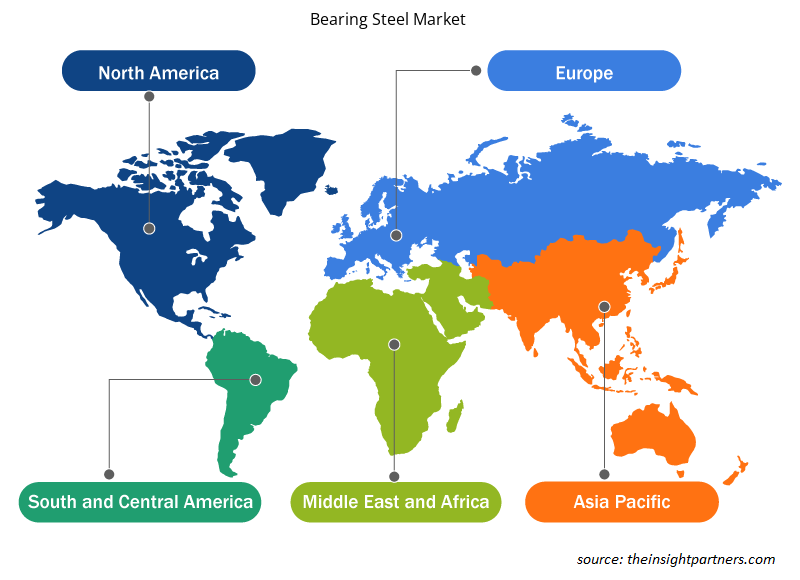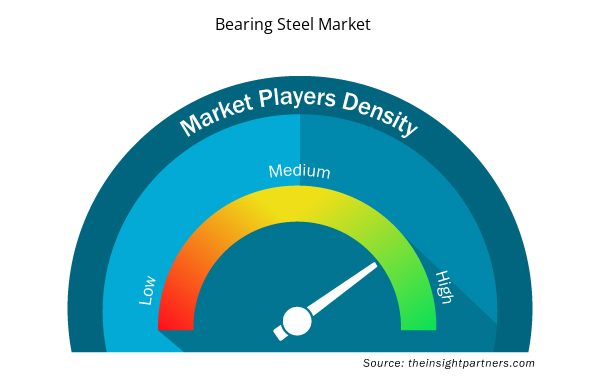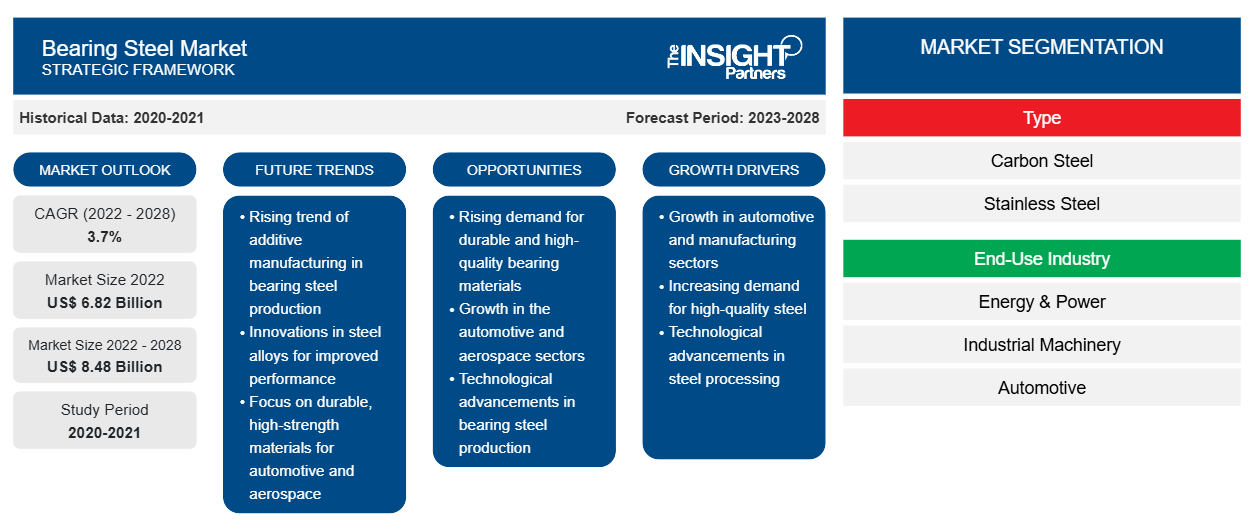[Forschungsbericht] Der Markt für Lagerstahl soll von 6.824,25 Millionen US-Dollar im Jahr 2022 auf 8.476,80 Millionen US-Dollar im Jahr 2028 wachsen; von 2022 bis 2028 wird eine durchschnittliche jährliche Wachstumsrate (CAGR) von 3,7 % erwartet.
Lagerstahl ist ein Spezialstahl mit hoher Verschleißfestigkeit und Rollermüdungsfestigkeit. Als Lagermaterialien werden kohlenstoffreicher Chrom-Lagerstahl, Maschinenbaustahl und einige Arten von rostfreiem Stahl und hitzebeständigem Stahl verwendet. Die wachsende Nachfrage nach Lagern aus der Automobilindustrie und die Entwicklung langlebiger und intelligenter Lager sind die Hauptfaktoren, die den Markt antreiben.
Der asiatisch-pazifische Raum hatte im Jahr 2022 den größten Umsatzanteil am globalen Markt für Lagerstahl . Der asiatisch-pazifische Raum ist die Heimat bedeutender Halbleiter- und Automobilunternehmen, darunter Samsung Electronics Co., Ltd., Sony Group Corporation, SK Hynix Inc., Toyota Motor Corporation, Tata Motors Ltd., Hyundai Motor Company, Nissan Motor Co., Ltd. und Honda Motor Co., Ltd. Lagerstahl wird häufig in Elektromotoren in Automobilen und Industriemaschinen verwendet, da er verschiedene Eigenschaften wie lange Lebensdauer, Fähigkeit, niedrigem und hohem Druck standzuhalten, und Kosteneffizienz aufweist. Laut einem Bericht der China Passenger Car Association lieferte Tesla Inc. im Jahr 2022 83.135 in China hergestellte Elektrofahrzeuge aus, was auf ein Wachstum der Verkäufe von Elektrofahrzeugen ab 2021 hindeutet. Laut dem Bericht der International Organization of Motor Vehicle Manufacturers betrug die Kraftfahrzeugproduktion im asiatisch-pazifischen Raum im Jahr 2021 ~46,73 Millionen Einheiten. Daher wird erwartet, dass die wachsende Automobilindustrie im asiatisch-pazifischen Raum im Prognosezeitraum günstige Geschäftsmöglichkeiten für den Markt für Lagerstahl in der Region schafft.
Passen Sie diesen Bericht Ihren Anforderungen an
Sie erhalten kostenlos individuelle Anpassungen an jedem Bericht, einschließlich Teilen dieses Berichts oder einer Analyse auf Länderebene, eines Excel-Datenpakets sowie tolle Angebote und Rabatte für Start-ups und Universitäten.
- Holen Sie sich die wichtigsten Markttrends aus diesem Bericht.Dieses KOSTENLOSE Beispiel umfasst eine Datenanalyse von Markttrends bis hin zu Schätzungen und Prognosen.
Auswirkungen der COVID-19-Pandemie auf den Lagerstahlmarkt
Vor dem Ausbruch von COVID-19 wuchs der Markt für Lagerstahl aufgrund der zunehmenden Verwendung von Lagern in den Bereichen Energie und Strom, Industriemaschinen, Automobil, Elektrik und Elektronik sowie Luft- und Raumfahrt. Die COVID-19-Pandemie bremste jedoch das Wachstum des Chemie- und Materialsektors und bremste damit das Wachstum des Marktes für Lagerstahl. Die Umsetzung von Maßnahmen zur Bekämpfung der Ausbreitung von SARS-CoV-2 wirkte sich negativ auf das Wachstum verschiedener Branchen aus. Die Hersteller erlebten Verzögerungen und erhöhte Kosten für importierte Rohstoffe aufgrund der langfristigen Schließung vieler Fabriken. Der durch die Auswirkungen der Pandemie auf die Endverbrauchsindustrien verursachte Schaden bremste die Nachfrage nach Lagerstahl.
Im Jahr 2021 begann sich der globale Markt von den durch die COVID-19-Pandemie verursachten Verlusten zu erholen, als die Regierungen verschiedener Länder Lockerungen der Beschränkungen ankündigten. Den Herstellern wurde gestattet, mit voller Kapazität zu arbeiten, was ihnen half, die Lücke zwischen Angebot und Nachfrage zu schließen. Dies wirkte sich positiv auf das Wachstum des Lagerstahlmarktes im Postpandemie-Szenario aus.
Markteinblicke
Wachsende Nachfrage nach Lagern aus der Automobilindustrie lässt das Wachstum des Lagerstahlmarktes ansteigen
Lager sind ein wichtiger Bestandteil von Automobilteilen und werden häufig in Motoren, Generatoren, Rädern, Getrieben, Antriebswellen, Lenkwellen und Lenkgetrieben verwendet. Ihre Tragfähigkeit und ihre Fähigkeit, Drehmoment zu übertragen, verbessern die Gesamtleistung rotierender Teile in einem Automobilsystem. Je nach spezifischer Anwendung kann die Leistung von Lagern durch die richtige Auswahl von Lagerstahl, Technologie und Schmierung während der Herstellung verbessert werden. Kohlenstoffstahl und Edelstahl werden häufig zur Herstellung von Lagern verwendet. Darüber hinaus verwenden Hersteller neue Rohstoffe wie leichte Stahllegierungen, um die Nachfrage der Automobilunternehmen nach leichten Materialien zu erfüllen. Die Verwendung von leichten Materialien ermöglicht es ihnen auch, mit den sich ändernden Emissionsnormen Schritt zu halten.
Typbasierte Erkenntnisse
Der globale Markt für Lagerstahl ist nach Typ in Kohlenstoffstahl, Edelstahl und andere unterteilt. Kohlenstoffstahl ist eine Legierung aus Kohlenstoff (bis zu 2,1 % Gewichtsanteil), Eisen und anderen Elementen. Kohlenstoffstahl bietet optimale Festigkeit, Belastbarkeit, Duktilität und Schweißbarkeit. Aufgrund seines hohen Festigkeits-Verschleiß-Verhältnisses bietet er eine lange Lebensdauer. Kohlenstoffstahl wird zur Herstellung von Halbpräzisions- oder Handelslagern und Lagerkomponenten verwendet. Kohlenstoffstahl für Lager muss mit Öl und Fett behandelt werden, da er nicht korrosionsbeständig ist. Daher wird er zur Herstellung von Lagern verwendet, die für Rollzüge, Einkaufswagen, Fahrräder, Rollschuhe, Schlösser und andere Anwendungen benötigt werden, bei denen die Lagerschmierung den industriellen Prozess nicht beeinträchtigt.
Ovako AB, Dongbei Special Steel Group Co Ltd, Ezm Edelstahlzieherei Mark Gmbh, Fushun Special Steel Co Ltd, Hbis Group Co Ltd, Saarstahl AG, Kobe Steel Ltd, Baosteel Group Corp, Benxi Iron and Steel Group Co Ltd und Sanyo Special Steel Co Ltd gehören zu den wichtigsten Akteuren auf dem globalen Markt für Lagerstahl. Die Marktteilnehmer konzentrieren sich darauf, qualitativ hochwertige Produkte anzubieten, um die Kundennachfrage zu erfüllen. Sie konzentrieren sich auch auf Strategien wie Investitionen in Forschung und Entwicklung, die Einführung neuer Produkte und die Erweiterung der Produktionskapazität.
Regionale Einblicke in den Markt für Lagerstahl
Die regionalen Trends und Faktoren, die den Markt für Lagerstahl im Prognosezeitraum beeinflussen, wurden von den Analysten von Insight Partners ausführlich erläutert. In diesem Abschnitt werden auch die Marktsegmente und die Geografie des Lagerstahls in Nordamerika, Europa, im asiatisch-pazifischen Raum, im Nahen Osten und Afrika sowie in Süd- und Mittelamerika erörtert.

- Erhalten Sie regionale Daten zum Markt für Lagerstahl
Umfang des Marktberichts über Lagerstahl
| Berichtsattribut | Details |
|---|---|
| Marktgröße im Jahr 2022 | 6,82 Milliarden US-Dollar |
| Marktgröße bis 2028 | 8,48 Milliarden US-Dollar |
| Globale CAGR (2022 - 2028) | 3,7 % |
| Historische Daten | 2020-2021 |
| Prognosezeitraum | 2023–2028 |
| Abgedeckte Segmente | Nach Typ
|
| Abgedeckte Regionen und Länder | Nordamerika
|
| Marktführer und wichtige Unternehmensprofile |
|
Marktteilnehmerdichte für Lagerstahl: Auswirkungen auf die Geschäftsdynamik verstehen
Der Markt für Lagerstahl wächst rasant, angetrieben durch die steigende Nachfrage der Endverbraucher aufgrund von Faktoren wie sich entwickelnden Verbraucherpräferenzen, technologischen Fortschritten und einem größeren Bewusstsein für die Vorteile des Produkts. Mit steigender Nachfrage erweitern Unternehmen ihr Angebot, entwickeln Innovationen, um die Bedürfnisse der Verbraucher zu erfüllen, und nutzen neue Trends, was das Marktwachstum weiter ankurbelt.
Die Marktteilnehmerdichte bezieht sich auf die Verteilung der Firmen oder Unternehmen, die in einem bestimmten Markt oder einer bestimmten Branche tätig sind. Sie gibt an, wie viele Wettbewerber (Marktteilnehmer) in einem bestimmten Marktraum im Verhältnis zu seiner Größe oder seinem gesamten Marktwert präsent sind.
Die wichtigsten auf dem Markt für Lagerstahl tätigen Unternehmen sind:
- Ovako AB
- Dongbei Spezialstahl Gruppe Co Ltd
- Ezm Edelstahlzieherei Mark GmbH
- Fushun Spezialstahl Co. Ltd
- Hbis Group Co Ltd
Haftungsausschluss : Die oben aufgeführten Unternehmen sind nicht in einer bestimmten Reihenfolge aufgeführt.

- Überblick über die wichtigsten Akteure auf dem Markt für Lagerstahl
Bericht-Spotlights
- Fortschrittliche Branchentrends auf dem Markt für Lagerstahl helfen den Akteuren bei der Entwicklung wirksamer langfristiger Strategien
- In Industrie- und Entwicklungsländern angewandte Strategien für Unternehmenswachstum
- Quantitative Analyse des Lagerstahlmarktes von 2020 bis 2028
- Schätzung der weltweiten Nachfrage nach Wälzlagerstahl
- Porters Fünf-Kräfte-Analyse zur Veranschaulichung der Wirksamkeit der in der Branche tätigen Käufer und Lieferanten
- Aktuelle Entwicklungen zum Verständnis des Wettbewerbsmarktszenarios
- Markttrends und -aussichten sowie Faktoren, die das Wachstum des Lagerstahlmarktes vorantreiben und bremsen
- Unterstützung im Entscheidungsprozess durch Aufzeigen von Marktstrategien, die das kommerzielle Interesse untermauern und zum Marktwachstum führen
- Die Marktgröße für Lagerstahl an verschiedenen Knotenpunkten
- Detaillierte Übersicht und Segmentierung des Marktes sowie der Dynamik der Lagerstahlindustrie
- Die Marktgröße von Lagerstahl in verschiedenen Regionen mit vielversprechenden Wachstumschancen
Globaler Markt für Lagerstahl – Segmentierung
Basierend auf dem Typ ist der globale Markt für Lagerstahl in Kohlenstoffstahl, Edelstahl und andere unterteilt. Basierend auf der Endverwendung ist der Markt für Lagerstahl in Energie und Strom, Industriemaschinen, Automobil, Elektrik und Elektronik, Luft- und Raumfahrt und andere unterteilt.
Firmenprofile
- Ovako AB
- Dongbei Spezialstahl Gruppe Co Ltd
- Ezm Edelstahlzieherei Mark GmbH
- Fushun Spezialstahl Co. Ltd
- Hbis Group Co Ltd
- Saarstahl AG
- Kobe Steel GmbH
- Baosteel Group Corp
- Benxi Eisen und Stahl Gruppe Co Ltd
- Sanyo Special Steel Co Ltd
- Historische Analyse (2 Jahre), Basisjahr, Prognose (7 Jahre) mit CAGR
- PEST- und SWOT-Analyse
- Marktgröße Wert/Volumen – Global, Regional, Land
- Branche und Wettbewerbsumfeld
- Excel-Datensatz



Report Coverage
Revenue forecast, Company Analysis, Industry landscape, Growth factors, and Trends

Segment Covered
This text is related
to segments covered.

Regional Scope
North America, Europe, Asia Pacific, Middle East & Africa, South & Central America

Country Scope
This text is related
to country scope.
Häufig gestellte Fragen
The global bearing steel market is primarily driven by the growing demand for bearings from the automotive industry and the development of durable and smart bearings.
Europe is estimated to register the fastest CAGR in the global bearing steel market over the forecast period. In Europe, there is an increasing utilization of bearing steel in excavators, loaders, dozers, dump trucks, graders, cranes, and forklifts in the construction sector. Moreover, the surge in investments by governments of various countries in Europe and private companies in infrastructure building & construction projects is anticipated to fuel the bearing steel market growth in Europe during the forecast period.
The automotive segment held the largest share of the global bearing steel market in 2022. In the automotive industry, steel-based bearings have end uses in various components, namely, wheels, electric motors, steering columns, driveshafts, engines, and automotive transmission systems.
In 2022, Asia Pacific held the largest share of the global bearing steel market. The growing automotive industry in the Asia Pacific is a major driving factor for the bearing steel market.
The carbon steel segment held the largest share of the global bearing steel market in 2022. Carbon steel offers optimum strength, load capacity, ductility, and weldability. It provides long service life due to its high strength-to-wear ratio. Carbon steel is used to manufacture semi-precision or commercial-grade bearings and bearing components.
Major players operating in the global bearing steel market include Ovako AB, Dongbei Special Steel Group Co Ltd, Ezm Edelstahlzieherei Mark Gmbh, Fushun Special Steel Co Ltd, Hbis Group Co Ltd, Saarstahl AG, Kobe Steel Ltd, Baosteel Group Corp, Benxi Iron And Steel Group Co Ltd, and Sanyo Special Steel Co Ltd.
Trends and growth analysis reports related to Chemicals and Materials : READ MORE..
The List of Companies - Bearing Steel Market
- Ovako AB
- Dongbei Special Steel Group Co Ltd
- Ezm Edelstahlzieherei Mark Gmbh
- Fushun Special Steel Co Ltd
- Hbis Group Co Ltd
- Saarstahl AG
- Kobe Steel Ltd
- Baosteel Group Corp
- Benxi Iron And Steel Group Co Ltd
- Sanyo Special Steel Co Ltd.
The Insight Partners performs research in 4 major stages: Data Collection & Secondary Research, Primary Research, Data Analysis and Data Triangulation & Final Review.
- Data Collection and Secondary Research:
As a market research and consulting firm operating from a decade, we have published and advised several client across the globe. First step for any study will start with an assessment of currently available data and insights from existing reports. Further, historical and current market information is collected from Investor Presentations, Annual Reports, SEC Filings, etc., and other information related to company’s performance and market positioning are gathered from Paid Databases (Factiva, Hoovers, and Reuters) and various other publications available in public domain.
Several associations trade associates, technical forums, institutes, societies and organization are accessed to gain technical as well as market related insights through their publications such as research papers, blogs and press releases related to the studies are referred to get cues about the market. Further, white papers, journals, magazines, and other news articles published in last 3 years are scrutinized and analyzed to understand the current market trends.
- Primary Research:
The primarily interview analysis comprise of data obtained from industry participants interview and answers to survey questions gathered by in-house primary team.
For primary research, interviews are conducted with industry experts/CEOs/Marketing Managers/VPs/Subject Matter Experts from both demand and supply side to get a 360-degree view of the market. The primary team conducts several interviews based on the complexity of the markets to understand the various market trends and dynamics which makes research more credible and precise.
A typical research interview fulfils the following functions:
- Provides first-hand information on the market size, market trends, growth trends, competitive landscape, and outlook
- Validates and strengthens in-house secondary research findings
- Develops the analysis team’s expertise and market understanding
Primary research involves email interactions and telephone interviews for each market, category, segment, and sub-segment across geographies. The participants who typically take part in such a process include, but are not limited to:
- Industry participants: VPs, business development managers, market intelligence managers and national sales managers
- Outside experts: Valuation experts, research analysts and key opinion leaders specializing in the electronics and semiconductor industry.
Below is the breakup of our primary respondents by company, designation, and region:

Once we receive the confirmation from primary research sources or primary respondents, we finalize the base year market estimation and forecast the data as per the macroeconomic and microeconomic factors assessed during data collection.
- Data Analysis:
Once data is validated through both secondary as well as primary respondents, we finalize the market estimations by hypothesis formulation and factor analysis at regional and country level.
- Macro-Economic Factor Analysis:
We analyse macroeconomic indicators such the gross domestic product (GDP), increase in the demand for goods and services across industries, technological advancement, regional economic growth, governmental policies, the influence of COVID-19, PEST analysis, and other aspects. This analysis aids in setting benchmarks for various nations/regions and approximating market splits. Additionally, the general trend of the aforementioned components aid in determining the market's development possibilities.
- Country Level Data:
Various factors that are especially aligned to the country are taken into account to determine the market size for a certain area and country, including the presence of vendors, such as headquarters and offices, the country's GDP, demand patterns, and industry growth. To comprehend the market dynamics for the nation, a number of growth variables, inhibitors, application areas, and current market trends are researched. The aforementioned elements aid in determining the country's overall market's growth potential.
- Company Profile:
The “Table of Contents” is formulated by listing and analyzing more than 25 - 30 companies operating in the market ecosystem across geographies. However, we profile only 10 companies as a standard practice in our syndicate reports. These 10 companies comprise leading, emerging, and regional players. Nonetheless, our analysis is not restricted to the 10 listed companies, we also analyze other companies present in the market to develop a holistic view and understand the prevailing trends. The “Company Profiles” section in the report covers key facts, business description, products & services, financial information, SWOT analysis, and key developments. The financial information presented is extracted from the annual reports and official documents of the publicly listed companies. Upon collecting the information for the sections of respective companies, we verify them via various primary sources and then compile the data in respective company profiles. The company level information helps us in deriving the base number as well as in forecasting the market size.
- Developing Base Number:
Aggregation of sales statistics (2020-2022) and macro-economic factor, and other secondary and primary research insights are utilized to arrive at base number and related market shares for 2022. The data gaps are identified in this step and relevant market data is analyzed, collected from paid primary interviews or databases. On finalizing the base year market size, forecasts are developed on the basis of macro-economic, industry and market growth factors and company level analysis.
- Data Triangulation and Final Review:
The market findings and base year market size calculations are validated from supply as well as demand side. Demand side validations are based on macro-economic factor analysis and benchmarks for respective regions and countries. In case of supply side validations, revenues of major companies are estimated (in case not available) based on industry benchmark, approximate number of employees, product portfolio, and primary interviews revenues are gathered. Further revenue from target product/service segment is assessed to avoid overshooting of market statistics. In case of heavy deviations between supply and demand side values, all thes steps are repeated to achieve synchronization.
We follow an iterative model, wherein we share our research findings with Subject Matter Experts (SME’s) and Key Opinion Leaders (KOLs) until consensus view of the market is not formulated – this model negates any drastic deviation in the opinions of experts. Only validated and universally acceptable research findings are quoted in our reports.
We have important check points that we use to validate our research findings – which we call – data triangulation, where we validate the information, we generate from secondary sources with primary interviews and then we re-validate with our internal data bases and Subject matter experts. This comprehensive model enables us to deliver high quality, reliable data in shortest possible time.


 Holen Sie sich ein kostenloses Muster für diesen Bericht
Holen Sie sich ein kostenloses Muster für diesen Bericht